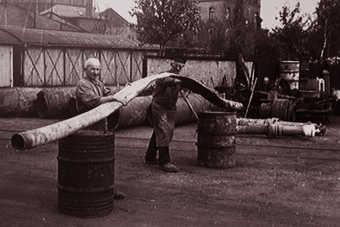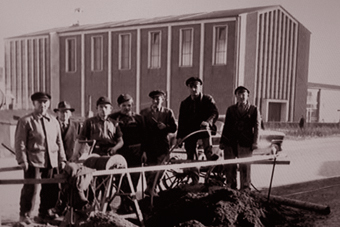THE INVISIBLE WORDS | DIE UNSICHTBAREN WORTE
KYUNGWOO CHUN | A PUBLIC ART PROJEKT | EIN KUNSTPROJEKT


An Aesthetic of Absence
Thoughts on a Participatory Art Project by Kyungwoo Chun
Ingo Clauß
Must art take on material form in order to achieve an impact in public awareness? At the latest since the nineteen-sixties, we have been confronted with artistic strategies which withdraw from direct view. There comes to mind Peter Weibel's formulation of an "aesthetic of absence."¹ And in fact, numerous works of contemporary art move within the dynamic field of presence and absence. As is well-known, there are conceptual works which are based upon a single idea or a simple set of instructions for performing an action. So it can be presupposed that art is not necessarily required to assume a concrete shape which is perceptible to the senses. One need only recall Sol LeWitt's theoretical statements concerning Conceptual Art: "Ideas can be works of art" (1969).² But the works of Lawrence Weiner and Michael Asher as well are early examples of an aesthetic practice which does not inherently aim at the production of visible images and objects. Thus the blank space becomes the actual artistic event.
In the museum, methods of concealment, reduction, and absence engender altered modes of seeing and thinking. This can only be successful, however, because the institution provides an appropriate context through which the blank space actually becomes marked and may be experienced as such. But what effect does this sort of procedure have in an urban setting? Publicly accessible sculptures and monuments are by their very nature oriented towards visibility, for they must compete for attention with countless objects and signs in an urban setting. The project of the artist and Bremen resident Kyungwoo Chun gives consideration to these particular aspects. Although the Invisible Words are spread throughout the municipal area, they will not be visible to passers-by. Everything created during the project literally disappears beneath the pavement of the city.
The sites of action are the municipal water pipes and electrical cables in Bremen and Bremerhaven. They constitute a dense underground network by means of which almost all households are connected. Today the provision of electricity, water, gas, and heating is taken for granted as an essential component of the public infrastructure—regardless of the fact that in most countries and communities, extensive sections of the networks have been privatized and are operated according to economic principles. Only when there are breakdowns does the underlying grid come to light, most often in an unpleasant manner. In some cases, a blackout can interfere with important processes or even render them impossible. These sorts of extreme situations demonstrate how urban life is fundamentally dependent on electricity and water. Kyungwoo Chun became interested in the unequal relationship between utilization and a lack of both perception and valuation.
An invitation was issued to 2,700 employees of swb, the local energy provider for Bremen and Bremerhaven. The point of departure was a question raised by the artist: "What words provide you and other people with energy and warmth?" Since September, the answers of the employees have been being collected and glued onto the supply lines for electricity, water, gas, and heating. Afterwards, the words are buried underground throughout the city independently of the planning of construction sites. It may be assumed that one day the words will be dug up and reexamined. This can occur in the near future or only in a few decades. Until then, the words will remain hidden underground.
Kyungwoo Chun makes already existing structures useful for the Invisible Words and, in a poetic manner, transforms them into art. A communal process gives rise to a structure in and beneath the city and thereby alters the perception of the urban environment. The participants inscribe themselves into the city space, as it were; with the possibilities offered by language, they conquer and describe a terra incognita lying beneath their feet. In this manner they add, parallel to the actual flow of energy, their own flow of thoughts and ideas awaiting discovery by a future generation. From this perspective, the Invisible Words are also simultaneously time capsules opening up a dialogue with the future.
The cooperation of many participants creates a linguistic texture which spreads out like a rhizome. The buried words constitute energetic nodes. Although they leave no physically perceptible changes above ground, they are henceforth present in the awareness of the participants. The city becomes charged symbolically, so to speak, so that it may be experienced as an alterable living space. For the participants, the streets lined with houses and the city districts where their words lie buried suddenly acquire an individual significance. Perhaps this or that person will feel curious, seek out "his or her street," and show it to friends and acquaintances. The sites of the Invisible Words could thereby establish themselves as personal landmarks and serve in the future as points of orientation in the city. Or with passing time they will be forgotten, will disappear not only below ground but also from people's memory, until perhaps one day they again come to light in public awareness. The Invisible Words are thus radically different from that which, whether with public or private financing, is generally presented as art in public spaces. This is not a matter of sculptures made from bronze and steel. Kyungwoo Chun aims at a collective (inter)action, at a process occurring in space and time.
On view at www.dieunsichtbarenworte.de is a map of Bremen and Bremerhaven upon which the various sites are indicated by name. Kyungwoo Chun uses the map as a crucial device for documenting the state and development of the project. The individual points are linked to the online service of Google Maps, so that it is possible to locate them quite precisely. The map, however, has far more significance than simply serving as a functional tool. It is a matter of an artistic representational system. Numerous artists have employed maps in their work or made use of the methods of scientific cartography.
The artistic collaboration with the employees of swb is an exciting endeavor which is nourished by its own momentum. The first discussions with the swb management already took place during the winter of 2010. After initial skepticism, swb became enthusiastic and committed itself to realizing this extraordinary undertaking. The employees were to be offered another perspective from which to experience their work, directly linked as it is to the municipal power supply. Kyungwoo Chun's aesthetic practice is highly suitable for this enterprise, inasmuch as it is a matter of artistic involvement, of a face-to-face dialogue between the artist and the corresponding employees. The Invisible Words could not come to be without the participation of these individuals. As co-authors, they are the fundamental prerequisite and an immanent component of the project.
The clear demarcation between artist and viewer is deliberately canceled. What remains is an open process which is not based on an artist with a sense of mission, but instead offers a possibility of collective interaction. As author and initiator, Kyungwoo Chun withdraws far into the background. He specifies a framework for action in which the participants can act independently and experience themselves as dynamic subjects with relative freedom within a fixed context. Ultimately it is their words, their personal thoughts and ideas, which make the work of art what it actually is.
¹Ulrike Lehmann / Peter Weibel (editors): Ästhetik der Absenz. Bilder zwischen Anwesenheit und Abwesenheit, Klinkhardt & Biermann, München/Berlin 1994
²„Ideas can be works of art; they are in a chain of development that may eventually find some form. All ideas need not be made “ in Sol LeWitt Sentences on Conceptual Art, 1969. Cf. also Sol LeWitt, Paragraphs on Conceptual Art, 1967.